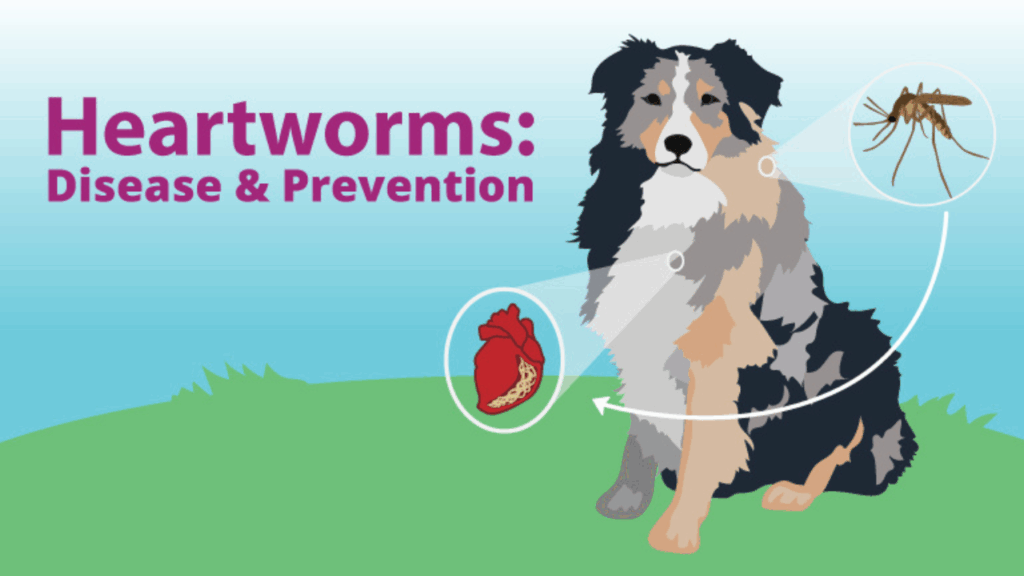Heartworm disease is a serious and potentially fatal condition that affects dogs across the world. Caused by parasitic worms that live in the heart, lungs, and blood vessels, this illness can lead to severe lung disease, heart failure, and organ damage. But how exactly do dogs get infected? And more importantly, how can you prevent it?
In this comprehensive guide, we’ll explain how dogs contract the disease, explore the lifecycle of the parasite, discuss signs of infection, and share important prevention tips to keep your furry friend safe and healthy.
What Is Heartworm Disease?
This disease is caused by a parasitic worm known as Dirofilaria immitis. Transmitted through the bite of an infected mosquito, the worms can grow up to 12 inches long and typically reside in the heart, lungs, and nearby blood vessels of affected animals.
Once infected, dogs can suffer from lasting damage, even after treatment. That’s why early prevention is far better—and far easier—than curing the disease after it develops.
How Do Dogs Get Heartworm?
READ MORE: Best Chews for Dogs’ Teeth
The answer is surprisingly simple: mosquitoes are the only known vectors for transmission. Here’s how it happens—when an infected mosquito bites a healthy animal, it can transfer the microscopic larvae into the new host, where they begin to grow and develop over time.
1. Mosquito Bites an Infected Animal
The lifecycle starts when a mosquito bites an infected host—such as a dog, coyote, fox, or wolf—and ingests immature larvae (called microfilariae) present in the animal’s bloodstream.
2. Larvae Develop Inside the Mosquito
Inside the mosquito, the microfilariae mature into infective larvae over the course of about 10–14 days, depending on temperature and climate conditions.
3. Mosquito Bites a Healthy Dog
When the infected mosquito bites a healthy dog, it transmits the infective larvae through the bite wound into the dog’s skin and tissue.
4. Larvae Migrate and Mature
Once inside the dog, the larvae migrate through the bloodstream and body tissues over the next several months, eventually making their way to the heart and pulmonary arteries, where they mature into adult worms.
5. Adult Worms Reproduce
Around 6 months after infection, the adult worms begin to reproduce, releasing microfilariae into the dog’s bloodstream. This makes the dog a host and a potential source for further transmission when another mosquito bites.
Where Is Heartworm Most Common?
While the disease is found in all 50 U.S. states and many countries worldwide, it’s especially common in warm, humid climates where mosquitoes thrive—such as coastal regions, wetlands, and the southeastern United States. These environments provide ideal breeding grounds for mosquito populations.
- The Southeastern United States
- The Gulf Coast
- Parts of Central and South America
- Asia and Australia
However, due to increased travel and changing climates, heartworm is now being reported in areas previously considered low-risk.
Can All Dogs Get Heartworm?
Yes. Any dog, regardless of age, breed, or location, can get heartworm if bitten by an infected mosquito. Dogs who spend a lot of time outdoors, especially near standing water or wooded areas, are at a higher risk. However, indoor dogs are not entirely safe either—mosquitoes can and do enter homes.
The Lifecycle of Heartworm in Dogs
To fully understand how dogs get heartworm, it helps to understand the parasite’s lifecycle:
- Microfilariae (baby worms) are present in the blood of an infected dog.
- A mosquito bites the dog and picks up the microfilariae.
- In the mosquito, the larvae mature into infective stage over 10–14 days.
- The mosquito bites another dog, depositing larvae.
- Larvae enter the dog’s bloodstream, migrating to the heart and lungs.
- Over 6–7 months, they grow into adult heartworms.
- Adult worms can live 5–7 years in dogs and produce more microfilariae, continuing the cycle.
Symptoms of Heartworm in Dogs
In the early stages, many dogs show no symptoms. As the infection progresses, signs become more noticeable. Symptoms include:
- Persistent cough
- Fatigue after moderate activity
- Decreased appetite
- Weight loss
- Swollen belly (from fluid buildup)
- Difficulty breathing
- In severe cases: collapse or sudden death
Routine veterinary checks and heartworm testing are crucial for catching infections early.
How Is Heartworm Diagnosed?
Heartworm is typically diagnosed through a blood test performed by a veterinarian. The most common tests include:
- Antigen test: Detects proteins from adult female heartworms.
- Microfilaria test: Identifies baby worms in the bloodstream.
Further diagnostic tools like X-rays, echocardiograms, or ultrasounds may be used to determine the severity of the infection.
Can Heartworm Be Treated?
Yes, but treatment is complex, expensive, and not without risk. If your dog tests positive:
- Activity restriction is essential. Physical activity can increase damage caused by worms.
- Medications are used to kill the adult worms gradually.
- In some cases, antibiotics and steroids are prescribed to reduce inflammation and treat secondary infections.
- Your vet may also use preventatives to stop new infections and eliminate microfilariae.
Note: Treatment can take several months, and in advanced cases, surgery may be required to remove adult worms from the heart.
How to Prevent Heartworm in Dogs
The good news is that heartworm disease is entirely preventable with consistent care.
Monthly Preventatives
Administer monthly heartworm preventatives, either oral or topical. These medications kill the larvae before they can mature into adult worms. Popular brands include:
- Heartgard
- Interceptor
- Sentinel
- Revolution
- Trifexis
Annual Testing
Even with regular prevention, annual heartworm testing is important. No medication is 100% foolproof, and early detection improves treatment outcomes.
Limit Mosquito Exposure
While you can’t eliminate all mosquitoes, you can reduce your dog’s risk by:
- Keeping them indoors at dusk and dawn (peak mosquito hours)
- Eliminating standing water in your yard
- Using vet-approved mosquito repellents
Common Myths About Heartworm
“My dog lives indoors, so they can’t get heartworm.”
Mosquitoes get indoors. Even indoor dogs need protection.
“Heartworm medication is only needed in summer.”
In many regions, mosquitoes are active year-round. Skipping even one dose can put your dog at risk.
“I’ll wait until my dog shows symptoms.”
By the time symptoms appear, the disease is already advanced and much harder to treat.
Final Thoughts
Heartworm disease is a serious threat, but it’s one that’s entirely preventable. Now that you know how dogs get heartworm, you can take the right steps to keep your pet safe.
Work closely with your veterinarian, use year-round preventatives, and make regular heartworm testing part of your dog’s routine care. A few simple steps can mean the difference between a healthy, happy dog—and one fighting a life-threatening infection.

Andy Parker is a dog lover, writer, and senior editor at BarkPicks. With years of experience covering canine health, training, and gear, he helps pet parents make smarter choices for happier, healthier dogs. Andy shares his home (and heart) with two rescue pups, Charlie and Mia.



